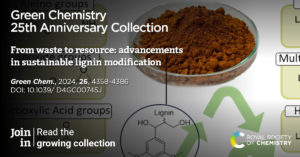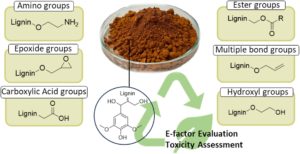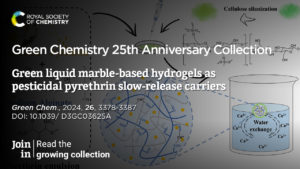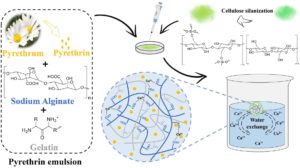
Over the past 25 years, Green Chemistry has provided a unique forum for the publication of innovative research on the development of alternative sustainable technologies, efficient utilisation of resources and the concomitant minimisation of waste. We are delighted to bring together a very special issue containing articles by members of the green chemistry community as well as past and present Green Chemistry Board members, to mark and celebrate our first 25 years.
 Among the contributions to this themed collection is a Critical review focusing on lignin, a biopolymer found in plants and trees (DOI: 10.1039/D4GC00745J). Chemical modifications of lignin are discussed and compared to each other in terms of sustainability aspects such as waste production and safety of the employed procedures. This literature review aims to increase awareness of the environmental implications that certain chemical procedures have, moreover wants to serve as a guide for researchers and industries towards more environmentally friendly practices.
Among the contributions to this themed collection is a Critical review focusing on lignin, a biopolymer found in plants and trees (DOI: 10.1039/D4GC00745J). Chemical modifications of lignin are discussed and compared to each other in terms of sustainability aspects such as waste production and safety of the employed procedures. This literature review aims to increase awareness of the environmental implications that certain chemical procedures have, moreover wants to serve as a guide for researchers and industries towards more environmentally friendly practices.
Read our interview with the authors.
How would you set this article in a wider context?
There is the need to increase awareness regarding sustainability aspects and we, as scientists, are in a key position to drive sustainable innovations and environmental awareness further. Our article addresses not only the important renewability aspect of lignin, but also emphasizes practical insights as well as safer and less waste producing approaches. Beyond academia, the concepts and methods we discuss are relevant to industries looking for ways to reduce their environmental footprint, for example by utilizing lignin byproduct as a precious starting material for further applications.
What is the motivation behind this work?
The utilization of renewable resources has been a core principle of sustainable chemistry, since Anastas and Warner introduced the 12 Principles of Green Chemistry in 1998, which lay the foundation of sustainable development in chemistry. In this context, lignin remains an underutilized and often overlooked resource. Moreover, usually protocols focus only on the renewability aspect apported by lignin, often neglecting critical factors like toxicity, waste generation, and the reliance on additional petrochemical-based reactants. Our work aims to provide a systematic overview of the key protocols present in the literature based on the environmental factor (E-factor) for waste generation as well as toxicity aspects. We also categorized protocols based on the functional groups introduced to lignin, facilitating readers seeking targeted modifications.
What aspects of this work are you most excited about at the moment and what do you find most challenging about it?
The most exciting aspect of this work is the opportunity to explore and expand the potential of lignin as a sustainable resource. We are particularly enthusiastic about continuing our research into innovative and more sustainable modification techniques for this biopolymer, which could open new possibilities for its application. However, one of the main challenges we faced was obtaining sufficient data for accurate E-factor calculations, as some previous studies did not report critical information such as reaction yields for lignin modifications. We thus also hope our work encourages researchers to consistently report comprehensive data and to also apply metrics for sustainability comparison.
What is the next step? What work is planned?
This review summarizes established procedures for lignin functionalization, along with essential principles for assessing the sustainability and safety of these processes. This assessment was important for us in identifying critical issues related to lignin modification and in designing safer and more sustainable modifications protocols. We would further be very happy if our review would be of value to other research teams in helping them to develop more sustainable uses of lignin within their respective fields of expertise. Currently, we are exploring alternative methods for lignin modification focusing of the use of lignin as macromonomer for various cross-linked polymeric materials.
Please describe your journey to becoming part of the Green Chemistry community
Our group has a strong research focus on Green Chemistry for about 20 years, in particular on the utilization of renewable materials in the most sustainable way possible. It was clear from the beginning that Green Chemistry is the way to contribute to some of the most important challenges of our society. Within the last years, seeing climate change advance and the dependence on fossil resources remain high, our dedication further strengthened – we are happy to be part of this growing community and that Green Chemistry has developed to a mainstream topic over the years. With this growth and all its positive aspects of new and exciting ideas and developments, however, we have to be careful of greenwashing also in academic research.
Why did you choose to publish in Green Chemistry?
We chose to publish in Green Chemistry because it is a highly renowned journal in the chemistry field, that aligns closely with our dedication to sustainable chemistry. Our manuscript discusses and compares different protocols for lignin modification based on their adherence to the principles of Green Chemistry, making this journal the ideal platform to reach a readership dedicated to similar goals. We are excited to contribute to this field and believe our work complements the journal’s mission to promote scientific advancements in sustainable chemistry.
What do you think the Green Chemistry journal has done well in the past 25 years, and what do you think are the main challenges our community will face in the next 25 years?
The journal Green Chemistry has always set high standards in this field by publishing innovative research with sustainable chemistry practices, it was and is a highly important part for the development of the research community. As the demand for greener solutions increases, it will be essential for the Green Chemistry community to continue developing innovative methodologies, ensuring that new processes are implemented by industry in order to contribute to a sustainable development. This is not an easy task, as fossil resources and environmentally unbenign approaches are often established and economically favorable, for instance because the cost of environmental burdens or greenhouse gas emissions are externalized to society. CO2 pricing might be the necessary gamechanger here, hopefully allowing many of the advances reported by the Green Chemistry community to be put into practice. A further and ongoing requirement will be societal awareness, improved for instance by education and outreach activities.
Meet the authors
 |
Celeste Libretti received her B.Sc. degree in Chemistry and Technologies for the Environment and Materials, and subsequently her M.Sc. degree in Industrial Chemistry, both from University of Bologna. She is currently a Ph.D. student in the working group of Prof. Dr Michael A. R. Meier, at the Karlsruhe Institute of Technology (KIT). Her research interests include cellulose and lignin structural modifications, as well as green chemistry. |
 |
Luis Santos Correa is a Ph.D. student working in the group of Prof. Dr Michael A. R. Meier at the Karlsruhe Institute of Technology (KIT). He received his B.Sc. and M.Sc. degree in chemistry from KIT. His master thesis focused on the oxidative cleavage of sunflower oil. He is currently working on the synthesis of polycarboxylic acids from renewable resources and their potential application in polymer chemistry. |
 |
Michael A. R. Meier studied chemistry in Regensburg (Germany) and received his Ph.D. from the Eindhoven University of Technology (The Netherlands) in 2006. After further stays in Emden and Potsdam, he was appointed as full professor at the Karlsruhe institute of Technology (KIT) in 2010. He has received several awards and is associate editor of ACS Sustainable Chemistry & Engineering. His research interests include the sustainable use and derivatization of renewable resources for polymer chemistry as well as the design of novel highly defined macromolecular architectures. |






















